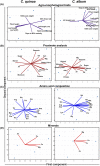Agro-morphological and nutritional assessment of chenopod and quinoa germplasm-Highly adaptable potential crops
- PMID: 37701188
- PMCID: PMC10494622
- DOI: 10.1002/fsn3.3502
Agro-morphological and nutritional assessment of chenopod and quinoa germplasm-Highly adaptable potential crops
Abstract
Quinoa belongs to the family Chenopodiaceae, a pseudo-grain having high nutritional value and is considered an underexploited vegetable crop with the potential to improve the nutritional security of millions. Therefore, assessing genetic diversity in Chenopodium germplasm to untap nutritional and site-specific adaptation potential would be of prime importance for breeders/researchers. The present study used 10 accessions of two Chenopodium species, that is, C. quinoa and C. album. Quantitative and qualitative phenotypic traits, proximate composition, minerals, and amino acids profiles were studied to compare the differences in nutritional value and extent of genetic diversity between these two species. Our results showed significant variation existed in yield attributing agro-morphological traits. All the traits were considered for hierarchical clustering and principal components analysis. Large genetic variability was observed in traits of Chenopodium accessions. The protein, dietary fiber, oil, and sugar content ranged from 16.6% to 19.7%, 16.8% to 26%, 3.54% to 8.46%, and 3.74% to 5.64%, respectively. The results showed that C. album and C. quinoa seeds had good nutritional value and health-promoting benefits. The C. quinoa was slightly ahead of than C. album in terms of nutritional value, but C. album accession IC415477 was at par for higher test weight, seed yield (117.02 g/plant), and other nutritional parameters with C. quinoa accessions. IC415477 and other potential accessions observed in this study may be taken up by breeders/researchers in the near future to dissect nutritional value of Chenopodium and related species for dietary diversity, which is imperative for the nutritional security of the ever-growing world's population.
Keywords: dietary diversity; genetic diversity; human health; nutritional composition; quinoa.
© 2023 The Authors. Food Science & Nutrition published by Wiley Periodicals LLC.
Conflict of interest statement
The authors declare that they have no competing financial interests and personal relationships that could have appeared to influence the work reported in this paper.
Figures





Similar articles
-
Elevated Genetic Diversity in an F2:6 Population of Quinoa (Chenopodium quinoa) Developed through an Inter-ecotype Cross.Front Plant Sci. 2016 Aug 17;7:1222. doi: 10.3389/fpls.2016.01222. eCollection 2016. Front Plant Sci. 2016. PMID: 27582753 Free PMC article.
-
Genetic and environmental influences on fatty acid and tocopherol diversity in quinoa germplasm.Front Plant Sci. 2025 May 15;16:1541895. doi: 10.3389/fpls.2025.1541895. eCollection 2025. Front Plant Sci. 2025. PMID: 40453342 Free PMC article.
-
Phenotypic Characterization of Quinoa (Chenopodium quinoa Willd.) for the Selection of Promising Materials for Breeding Programs.Plants (Basel). 2021 Jun 30;10(7):1339. doi: 10.3390/plants10071339. Plants (Basel). 2021. PMID: 34209112 Free PMC article.
-
Research Progress of Quinoa Seeds (Chenopodium quinoa Wild.): Nutritional Components, Technological Treatment, and Application.Foods. 2023 May 22;12(10):2087. doi: 10.3390/foods12102087. Foods. 2023. PMID: 37238905 Free PMC article. Review.
-
Quinoa: Nutritional, functional, and antinutritional aspects.Crit Rev Food Sci Nutr. 2017 May 24;57(8):1618-1630. doi: 10.1080/10408398.2014.1001811. Crit Rev Food Sci Nutr. 2017. PMID: 26114306 Review.
References
-
- Abugoch, L. E. , Romero, N. , Tapia, C. A. , Silva, J. , & Rivera, M. (2008). Study of some physicochemical and functional properties of quinoa (Chenopodium quinoa wild) protein isolates. Journal of Agricultural and Food Chemistry, 56, 4745–4750. - PubMed
-
- Aguilar, P. C. , & Jacobsen, S. E. (2003). Cultivation of quinoa on the Peruvian altiplano. Food Review International, 19, 31–41.
-
- Ahamed, N. T. , Singhal, R. S. , Kulkarni, P. R. , Kale, D. D. , & Pal, M. (1998). A lesser–known grain, Chenopodium quinoa: Review of the chemical composition of its edible parts. Food and Nutrition Bulletin, 19, 61–69.
-
- Alemayehu, N. , & Becker, H. (2002). Genotypic diversity and patterns of variation in a germplasm material of Ethiopian mustard (Brassica carinata a. Braun). Genetic Resources and Crop Evolution, 49, 573–582.
-
- Al‐Naggar, A. M. M. , Abd El‐Salam, R. M. , Badran, A. E. E. , & El‐Moghazi, M. A. (2017). Heritability and interrelationships for agronomic, physiological and yield traits of quinoa (Chenopodium quinoaWilld.) under elevated water stress. Archives of Current Research International, 10, 1–15.
LinkOut - more resources
Full Text Sources

